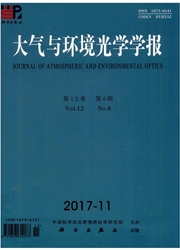

 中文摘要:
中文摘要:
利用世界温室气体数据中心(WDCGG)数据资料和WMO资料,对中国大陆及周边国家和地区的主要温室气体CO2浓度等进行了初步分析。分析结果表明:总体而言,中国大陆瓦里关全球大气本底站与中国香港、日本、俄罗斯、韩国等周边国家和地区CO2浓度水平相近,变化趋势一致;中国香港和韩国CO2的浓度较高,日本、俄罗斯和中国瓦里关的浓度较低。多年观测数据的研究分析显示,北半球CO2平均浓度呈现逐年升高态势,且CO2平均年变化幅度与观测站所处海拔高度成反比。中国瓦里关全球大气本底站与美国MaunaLoa、Barrow、TrinidadHead全球大气本底站CO2浓度水平和变化趋势较为一致,年际变化幅度略高于MaunaLoa站,低于Barrow站。中国上甸子区域大气本底站CO2浓度变化比瓦里关及美国MaunaLoa、Barrow、TrinidadHead站剧烈,显示出上甸子站受区域排放影响较强的特性。
 英文摘要:
英文摘要:
Using the data of World Data Center for Greenhouse Gases (WDCGG) and WMO, the concen- trations of the main greenhouse gas CO2 in China and its surrounding countries and regions are preliminarily analyzed. The results show that: the CO2 concentrations in China mainland are close to Hong Kong in China, Japan, Russia, and South Korea; they all have the same trends. Higher CO2 concentrations are found in Hong Kong in China and South Korea, while lower CO2 concentrations in Japan, Russia, Waliguan in China. The results of many years observation show that the average concentration of CO2 in the northern hemisphere is increasing year by year, and the average annual variation of CO2 concentration is inversely proportional to the altitude of the observation station. The concentration and variation trend of CO2 in Waliguan Global Station is consistent with that in the Mauna Loa, Barrow, Trinidad Head global station. But the annual variation in Waliguan is slightly higher than in Mauna Loa, and lower than in Barrow. The changes of CO2 concentration in Shangdianzi Regional Background Station in China are more violent than in Waliguan, Mauna Loa, Barrow, Trinidad Head Stations, which shows that Shangdianzi Station is affected by the stronger regional emissions.
 同期刊论文项目
同期刊论文项目
 同项目期刊论文
同项目期刊论文
 期刊信息
期刊信息
